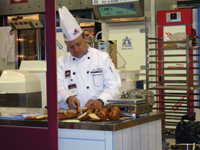
Guest Column: May 2010
April 22, 2010
By
FORMA-LAB
Former Team Canada coach Mario Fortin recounts his experience as president of the jury at Europain’s competition for individual artisan bakers.
Former Team Canada coach Mario Fortin recounts his experience as
president of the jury at Europain’s competition for individual artisan
bakers.

|
First, let me share some of my experiences in international competitive baking that led to my role at Europain 2010.
I was part of Team Canada for the first Louis Lesaffre Cup in 2004, a qualification round for the 2005 Bakery World Cup. We finished second behind Denmark, so we did not qualify for the Bakery World Cup. I was invited to do a demonstration of bread from North America during the first day at Europain 2005.
In 2007, I used my experience from 2004 to be Team Canada’s coach for the Louis Lesaffre Cup in Mexico, and again we finished second. This Louis Lesaffre Cup was to qualify for the 2008 World Baking Cup in Paris. Only the winner gets to advance.
The organizers of Europain recognized the work I did with Team Canada and invited me to be a member of jury for the 2008 Bakery World Cup. It was a great experience with a fantastic worldwide exchange.
The Europain show had been every three years, but when the organizers decided to bring it back to every two years, they didn’t have enough time to stage a Louis Lesaffre Cup on each continent. They created the inaugural edition of the Bakery Masters by choosing the 12 best bakers from the last World Cup, the six best from the 2007 Louis Lesaffre Cup and six “wild cards.” So, 24 candidates from 17 countries would perform individually in their own speciality, meaning there were eight contenders for each category: bread, Viennese pastry and artistic piece.
Last October, I was at the IBA show in Dusseldorf, Germany, where I met the founder of the Bakery World Cup, Christian Vabret. He asked me if I would accept the role of jury president for the first edition of the Bakery Masters. I never hesitated in saying “yes,” and thanked him for this recognition.
I had to keep this secret until the competition because nobody was supposed to know who would be judging the competition before the first day. Even as president of the jury, I didn’t know who the seven jury members would be.
The slogan of the Bakery Masters was “Raising the Status of Bakers.” In keeping with this theme, the jury had to operate with the highest degree of integrity, as it was the ultimate decision-making body for the contest.
Operating in accordance with the instructions given by the jury chairman, it was composed of seven members and myself, the president. The president and members of the jury were appointed by the organizational committee. They were of different nationalities to those of the competing countries, and were chosen for their professional skill and reputation.
The jury chairman does not award scores. He or she is responsible for ensuring that the rules and spirit of the competition are upheld by the jury members and competitors. At any time the chairman may choose to disqualify a competitor or jury member who fails to observe the rules. If the chairman is unable to attend, any person of his choice may represent him or her.
The president, on the other hand, has to answer the technical questions from the candidates. He gives the signal for the starting time of the working day.
In my role as president, I also had to keep the candidates confident so they would do their best. I reminded them to work as cleanly and professionally as possible in front of the audiences watching them. I kept track of time, noting those who finished late. I was also in charge of checking product weight, length and the amount made.
The members of the jury were to have no links with any of the competitors and competing countries, via their families, their work, through training or the provision of advice.
The scores awarded by the jury were collected each day and recorded in a computer system. The jury could make any modifications they deemed necessary up to the evening prior to the announcement of the results.
The jury members were not allowed to enter the baking areas during the trials. The only persons authorized to do so were the jury chairman, the two co-ordinators, the equipment and raw materials supervisors and any other person appointed by the chairman.
On the day before the competition, the competitors presented their equipment and ingredients to the chairman. As president, I had to be on site from the beginning of the day at 4 a.m. until the end at 8 p.m.
After the four days of competition, I gave a speech – in three languages – in which I announced the winners of each category. They were:
- Master Baker 2010 for Bread: Pao Chun Wu of Taiwan
- Master Baker 2010 for Viennese Pastry: Thomas Planchot of France
- Master Baker 2010 for Artistic Piece: François Brandt of the Netherlands.
It was a great experience with unforgettable memories. I am proud that I was up to the challenge.
Print this page
Leave a Reply